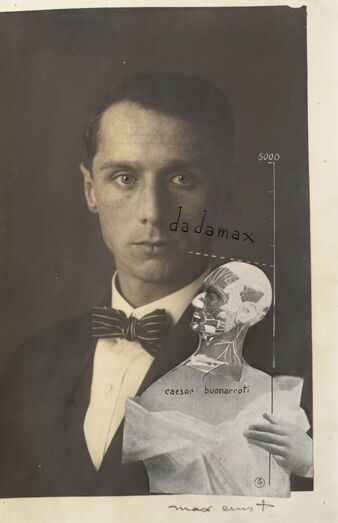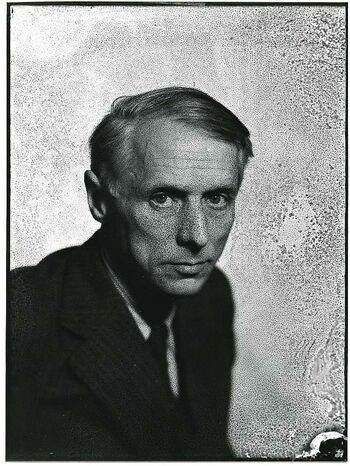Max Ernst
 Max Ernst, The Punching Ball ou l’immortalité de Buonarroti [The Punching Ball or the Immortality of Buonarroti], 1920. Gelatin silver print, photomechanical print, gouache, and ink. 17.6 × 11.4 cm. | |
| Born |
April 2, 1891 Brühl, German Empire |
|---|---|
| Died |
April 1, 1976 (aged 84) Paris, France |
| Web | UbuWeb Sound, Dada Companion, Aaaaarg, Wikipedia |
Max Ernst (1891-1976) was a German painter, sculptor, graphic artist, and poet. A prolific artist, Ernst was a primary pioneer of the Dada movement and Surrealism.
Life and work[edit]
Max Ernst was born on 2 April 1891, in Brühl, six miles south of Cologne, to Phillip Joseph Ernst, a teacher at Brühl's Institute for the Deaf and Dumb, and Louise Ernst, née Kopp. The third of nine children and the oldest son to live beyond childhood, Ernst was raised in a well-to-do Catholic household. His father was an amateur painter who encouraged Ernst to paint. In 1910 Ernst enrolled at the University of Bonn, where he focused on courses in the history of art, psychology, philosophy, philology, and literature. In the summer and fall of 1912 Ernst was actively engaged with the group of artists around the expressionist painter August Macke and began writing art criticism for the newspaper Volksmund in Bonn. A year later, Ernst exhibited his work for the first time with Macke's group Die Rheinischen Expressionisten [The Rhineland Expressionists] in Bonn and at the First German Autumn Salon at Herwarth Walden's Sturm Gallery in Berlin. His early works wrestled with the influence of cubism, futurism, and expressionism. During a visit to the exhibition of the German Association of Craftsmen in Cologne in 1914, Max Ernst met Hans Arp, an encounter that would develop into a meaningful artistic friendship.
Ernst enlisted in the Twenty-third Field Artillery Regiment in Koblenz on 24 August 1914. Serving on the Western Front near Laon and Soissons from July 1915 to March 1916, Ernst suffered minor head and hand injuries. In January 1916 over fifty of Ernst's works were displayed in a two-man exhibition, Max Ernst: George Muche, at Sturm Gallery in Berlin. Ernst was granted a military leave of absence and traveled to Berlin in early January 1916, where he met George Grosz and Wieland Herzfelde during his visit. In November 1916 Ernst was transferred to the Eastern Front, where he stayed until mid-May 1917, when he was moved to the Sixteenth Infantry Division in Belgium. Ernst was awarded the Iron Cross, first and second class, for his military service. He continued to publish articles on art during the war, including "On the Origins of Color" in Der Sturm, August 1917. On 17 October 1918, a month before the end of the war, Ernst married Luise Amelie Straus, an art historian. Herzfelde was among the guests.
After the war, Ernst elected to pursue art instead of his university education. He established contacts with emerging socialist and avant-garde art groups in 1918 and 1919 and joined the Society of Arts founded by Karl Nierendorf and connected to the group Der Strom [The Current]. In the winter of 1919, Ernst collaborated with Johannes Baargeld on Der Ventilator [The Fan], a short-lived leftist journal disguised as an entertainment weekly that became an artistic and political outlet for avant-garde artists during the British occupation of Cologne.
- Dada
In the summer of 1919, during a visit to Paul Klee's atelier in Munich, Max Ernst met Zurich Dada members Hugo Ball and Emmy Hennings and was exposed to Zurich Dada publications at Goltz's, a gallery and bookstore. Cologne Dada emerged shortly thereafter, its members including Ernst, Baargeld, Hans Arp, Angelika and Heinrich Hoerle, Willy Fick, Anton Räderscheidt, and Franz Seiwert. Ernst and Baargeld organized the exhibition of the Bulletin D group in 1919. The show and the accompanying catalogue constituted the first manifestation of Cologne Dada and caught the attention of artist and collector Katherine Dreier, who then brought news of Bulletin D to Paris. In April 1920, outraged at their exclusion from a jury-free museum exhibition, Baargeld and Ernst rented the courtyard of a pub, the Brauhaus Winter, and mounted their own show, the Dada-Vorfrühling (Dada Early Spring) exhibition. Ernst's son Ulrich (later called Jimmy) was born shortly thereafter, on June 24, 1920. In October 1920 Ernst and Arp collaborated on their first FaTaGaGa--short for FAbrikation de Tableaux GAsométriques Garantis [Fabrication of Guaranteed Gasometric Paintings].
In May 1921 the Exposition Dada Max Ernst opened at Au Sans Pareil, Paris, with a catalogue including a preface by André Breton, but Ernst was unable to get a passport and could not attend. In November 1921 the French poet Paul Eluard traveled to Cologne with his wife Gala to visit the Ernsts. Eluard not only bought Ernst's painting Célèbes but also chose eleven of Ernst's collages for his volume of poetry, Répétitions, published on 18 March 1922. Ernst and Eluard collaborated on another volume of poetry and collages, Les Malheurs des immortels [The Misfortunes of the Immortals], published in July 1922 by Librairie Six, Paris. In August 1922, with the ambition of establishing himself in Paris, Ernst left his wife and child and moved in with Paul and Gala Eluard in Paris, continuing the collaboration and the ménage à trois begun earlier that year. Ernst subsequently became a major force in the surrealist movement. (Source)
tbc...
Publications[edit]
- with Alfred Ferdinand Gruenwald, Die Schammade: (dilettanten erhebt euch) / Dadameter, Cologne: Schloemilch, 1920, 32 pp. (German)
- with Paul Eluard, Les malheurs des immortels, Paris: Librairie Six, 1922, 43 pp, KHZ, IDL. (French)
- La femme 100 têtes, 1929. A "collage novel". [1] (French)
- The Hundred Headless Woman, forew. André Breton, trans. Dorothea Tanning, New York: Braziller, 1981. (English)
- Une semaine de bonté ou les sept éléments capitaux, 5 vols., Paris: Jeanne Bucher, 1934. A "collage novel" created by cutting up and re-organizing 182 illustrations from Victorian encyclopedias and novels. [2] [3] [4] [5] [6] [7] [8]
- Une semaine de bonté: A Surrealistic Novel in Collage. A Week of Kindness or The Seven Deadly Elements, New York: Dover, 1976, xi+208 pp. (English)
- Nedelya dobroty, ili Sem smertelnykh elementov [Неделя доброты или Семь смертельных элементов], 2009, 195 pp. [9] (Russian)
Catalogues[edit]
- Exposition Dada Max Ernst: du 3 mai au 3 juin, Paris: Au sans pareil, 1921, 6 pp, IDA. (French)
- Estampes et livres illustrés, eds. Jean Adhémar and Mariel Frèrebeau, Paris: Bibliothèque nationale, 1975, xiv+13+[54] pp. (French)
- Max Ernst: A Retrospective, New York: Solomon R. Guggenheim Museum, 1975, 273 pp. (English)
- Werner Spies, Max Ernst Collages: The Invention of the Surrealist Universe, New York: Abrams, 1991, 540 pp. (English)
- William A. Camfield, Max Ernst: Dada and the Dawn of Surrealism, intro. Werner Spies, pref. Walter Hopps, Munich: Prestel, 1993, 373 pp. (English)
- Max Ernst: A Retrospective, eds. Werner Spies and Sabine Rewald, Metropolitan Museum of Art and Yale University Press, 2005. (English)
Literature[edit]
- Pamela Pricker, Ernst, New York: Amiel, 1975. (English)
- Werner Spies, Max Ernst: Life and Work, London, 2006. (English)
